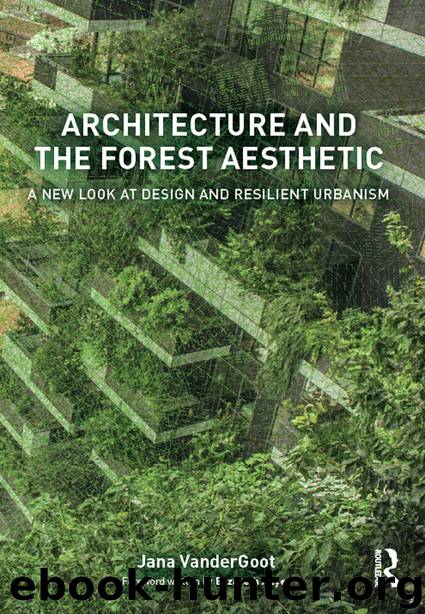Architecture and the Forest Aesthetic by VanderGoot Jana;

Author:VanderGoot, Jana;
Language: eng
Format: epub
Publisher: Taylor & Francis Group
FIGURE 4.13
Oslo and Oslomarka from Frognerseteren Station train, 2016
FIGURE 4.14
Coffee Camp, Future Library Forest, 2016
FIGURE 4.15
Ceremony theater, Future Library Forest, 2016
FIGURE 4.16
Ceremony theater panorama, Future Library Forest, 2016
NOTES
1. Markaloven (Marka Act), Chapter 2 Section 5, September 1, 2009, accessed October 1, 2016, https://lovdata.no/dokument/NL/lov/2009–06–05–35#KAPITTEL_2. The Marka Act expresses a long-term vision of development in Marka by restricting construction. The phrase “slow space” is also a reference to Slow Space Programme and development work of Bjørvika Utvikling in Bjørvika, Oslo. Future Library was commissioned as part of the Slow Space Programme in Bjørvika.
2. Norwegian forestry practice was discussed in author’s interview on November 23, 2016 with Jon Christiansen, head of the forest owned by the city of Oslo.
3. Hugh M. Raup, “The View from John Sanderson’s Farm: A Perspective for the Use of the Land,” Forest History 10, no. 1 (1966): 11.
4. Hand-over Urbanism is a term applied to the Future Library project by the author (JVG). It describes an urban project that requires intermittent maintenance or development, and its time span is such that the entire project cannot be completed by those beginning it, thus requiring a hand-over to new participants during the term of the project.
5. For more on allmenningsskogene see: Tallak Molland, Historien Om Nordmarka: Gjennom De Siste 200 År. (Oslo: Christiania forlag, 2006), 20.
6. Karen V. Lykke Syse, “Oslo: A City Framed by Forest,” Green Oslo: Visions, Planning and Discourse (Ed.) Mark Luccarelli, and Per Gunnar Røe (Farnham, UK: Ashgate, 2012), 54.
7. Ibid, 48.
8. Author discussed original land purchase by Oslo in an interview on November 23, 2016 with Jon Christiansen, head of the forest owned by the city of Oslo. See also Molland, Historien Om Nordmarka.
9. Henri Lefebvre, “Towards an Urban Strategy,” in The Urban Revolution, trans. Robert Bononno (Minneapolis, MN: University of Minnesota Press, 2003) 150.
10. From author’s interview with Future Library artist Katie Paterson on February 19, 2016.
11. Future Library was commissioned by Bjørvika Utvikling and is managed by the Future Library Trust, whose trustees include the artist, Publishing Director of Hamish Hamilton Simon Prosser, former Director of the Deichmanske Bibliotek Liv Sæteren, Publishing Director of Forlaget Press Håkon Harket, Editor in Chief of Oktober Press Ingeri Engelstad, and Anne Beate Hovind, Bjørvika Utvikling’s Project Manager for the Slow Space Programme. Future Library is supported by City of Oslo Department of Cultural Affairs and Business, Department of Environmental Affairs and Transportation and Norwegian Public Roads Administration SVRØ.
12. Lefebvre, Urban Revolution, 29 and 5. See also Neil Smith, foreword to Urban Revolution by Henri Lefebvre (Minneapolis, MN: University of Minnesota Press, 2003), xix. Lefebvre writes about the urban and the urban revolution as something that comes after the age of agriculture and industrialization.
13. Molland, Historien, 21.
14. James Scott, “Nature and Space,” in Seeing Like a State: How Certain Schemes to Improve the Human Condition Have Failed (Ed.) James Scott (New Haven, CT: Yale University Press, 1998), 12–13. Scott discusses the absent social dimension of Norway spruce monocultures and argues that the state’s vision for industry and
Download
This site does not store any files on its server. We only index and link to content provided by other sites. Please contact the content providers to delete copyright contents if any and email us, we'll remove relevant links or contents immediately.
Kathy Andrews Collection by Kathy Andrews(11316)
The remains of the day by Kazuo Ishiguro(8377)
Paper Towns by Green John(4785)
Spare by Prince Harry The Duke of Sussex(4780)
Industrial Automation from Scratch: A hands-on guide to using sensors, actuators, PLCs, HMIs, and SCADA to automate industrial processes by Olushola Akande(4584)
The Body: A Guide for Occupants by Bill Bryson(4577)
Be in a Treehouse by Pete Nelson(3642)
Harry Potter and the Goblet Of Fire by J.K. Rowling(3603)
Machine Learning at Scale with H2O by Gregory Keys | David Whiting(3596)
Never by Ken Follett(3515)
Goodbye Paradise(3441)
The Remains of the Day by Kazuo Ishiguro(3130)
Into Thin Air by Jon Krakauer(3125)
The Cellar by Natasha Preston(3073)
The Genius of Japanese Carpentry by Azby Brown(3033)
Drawing Shortcuts: Developing Quick Drawing Skills Using Today's Technology by Leggitt Jim(2936)
120 Days of Sodom by Marquis de Sade(2935)
Fairy Tale by Stephen King(2932)
The Man Who Died Twice by Richard Osman(2799)
